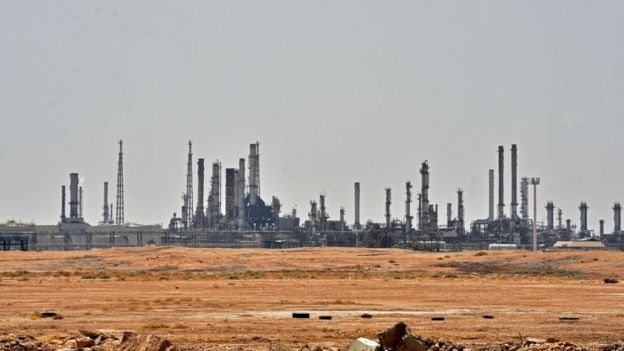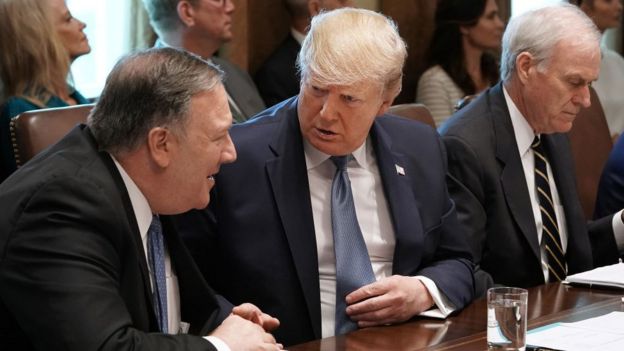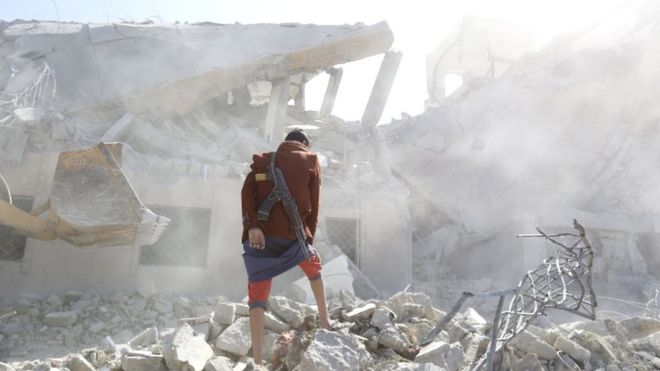
Saudi Arabia raced to restart its oil production following the attacks


Mike Pompeo (L) said the US and its allies would ensure "Iran is held accountable"
'Drone' attack on Saudis destabilises an already volatile region
Jonathan Marcus
Diplomatic correspondent
The Houthis say they did it; the United States insists that it was Iran; the Iranians deny any involvement.
A predictable war of words has followed the dramatic attack on Saudi Arabia's most important oil installations. The strikes have shown the remarkable vulnerability of oil facilities of central importance to the global economy.
The Saudis - whose air campaign in Yemen is backed by the Americans and whose warplanes are only kept in the sky by a variety of western contractors - have been conducting a long-running air campaign against the Houthi rebels. But their opponents have now demonstrated the ability to deliver a strategic riposte of their own.
The whole episode has inevitably revived the debate about the extent to which Iran is providing technology and assistance to the Houthis. Given the already highly charged atmosphere in the Gulf, it has served to ratchet up regional tensions.
Why is there a war in Yemen?
Yemen war: Has anything been achieved?
But equally it has also revealed some of the failings in the Trump administration's declared policy of exerting "maximum pressure" against Tehran.
Amidst the claims and counter-claims, there is still a good deal that we do not know. The Houthis have used both drones and missiles to hit Saudi targets before.
But the drone attacks have generally had only limited success. Both the range over which this most recent operation was conducted and the accuracy and scale of the strikes make this a different order of magnitude altogether.
So was it really armed drones (UAVs) that conducted these attacks, or was it some kind of missile strike? And if the latter, why were Saudi air defences not alerted? Were the attacks launched from Houthi-controlled territory or from somewhere else? Might pro-Iranian groups in Iraq have been involved or maybe the Iranians themselves?
The US Secretary of State Mike Pompeo was quick to point the finger of blame at Tehran, but he did so seemingly before any clear intelligence was available; certainly he did not offer any of it up for immediate public scrutiny.
Several hours later, US sources indicate that there were some 17 points of impact from the attack, all suggesting that they came from the north or north-west - that is to say, more likely from Iran or Iraq, rather than from Yemen to the south.
The US is promising more details in due course and some of the drones or missiles that failed to reach their targets are now being analysed.
Iran has well-developed ties with the Houthis and there is little doubt it has been the key player in enabling them to develop their long-range strike capability, whether through armed UAVs or missiles.
In 2018, a report from a UN expert panel pointed to the remarkable similarity between the Houthi Qasef-1 UAV and the Iranian Ababil-T. In a wide-ranging study, it asserted that Iran had broken the arms embargo against Yemen and supplied the Houthis with a variety of weapons systems.
Much the same conclusion was reached by a March 2017 study from the independent Conflict Armament Research organisation, which focused on Iranian UAV assistance.
However, the Qasef-1/Ababil-T only has a range of about 100-150km. The distance from the Yemeni border to the closest target - the Khurais oil field - is about 770km. So if these recent attacks were carried out by a UAV it would have to have been of an altogether different design, with hugely increased range and a significantly greater level of reliability.
Iran and thus possibly the Houthis do indeed have longer-range systems, but so far there has been little evidence of their deployment in the Yemen conflict. Some kind of cruise missile might also be a possibility, perhaps fired from either Iraq or Iran, but clarity on these questions will require access to reliable intelligence information.
In some ways, though, the precise details don't matter. The diplomatic damage has already been done. The US and the Saudis are implacable enemies of Iran. The Trump administration has already made its mind up, blaming Tehran for the mining of ships in the Gulf. Iran has openly seized a British-flagged tanker, albeit after the arrest of a ship carrying Iranian oil off Gibraltar.
Iranian tanker's oil 'sold' in defiance of US
US offered millions to Iranian tanker captain
Iran 'will never talk directly to US'
So as far as team Trump is concerned, the Iranians' fingerprints are all over the Houthis' escalating strategic campaign against Saudi Arabia's oil infrastructure.
Saudi Arabia raced to restart its oil production following the attacks
The question now is what are they going to do about it, or perhaps what can they do about it? And the answer may be: not very much. The US is already firmly in the Saudi corner, despite the growing unpopularity of the Yemen war on Capitol Hill, where there is a growing sense that the Saudi air campaign is pointless, serving only to turn an already impoverished country into a humanitarian disaster zone.
But there is a curious aspect revealed by these infrastructure attacks. For all the Trump administration's support for the Saudis and for all its stress on "maximum pressure", in reality, Washington is sending very mixed signals to Tehran.
Mr Trump, after all seems, willing to countenance a face-to-face meeting with the Iranians on the margins of the upcoming UN General Assembly and he has just fired his National Security Adviser, John Bolton, the man most associated with the idea of regime change in Tehran.
Iran, along with its Houthi allies, is conducting a classic war of the weak against the strong; a "hybrid conflict" as it is known in the strategic textbooks. It is borrowing many of the tactics from the Russian play-book - the use of deniability; proxies; cyber-operations and information warfare.
Tehran knows that Mr Trump, for all his bluster and unpredictability, wants to get the US out of military entanglements and not into new ones. That gives the Iranians the ability to apply some "maximum pressure" of their own.
The danger remains that miscalculation could lead to an all-out conflict, which nobody really wants.
Source: BBC
الهجوم "بدون طيار" على السعوديين يزعزع الاستقرار في منطقة مضطربة بالفعل
جوناثان ماركوس
المراسل الدبلوماسي
يقول الحوثيون إنهم فعلوا ذلك ؛ الولايات المتحدة تصر على أنها إيران. الإيرانيون ينكرون أي تورط.
حرب الكلمات يمكن التنبؤ بها في أعقاب الهجوم الكبير على أهم المنشآت النفطية في المملكة العربية السعودية. أظهرت الإضرابات الضعف الكبير للمنشآت النفطية ذات الأهمية المركزية للاقتصاد العالمي.
السعوديون - الذين تدعم حملتهم الجوية في اليمن من قبل الأمريكيين والذين لا يتم الاحتفاظ بطائراتهم الحربية في السماء إلا من قبل مجموعة متنوعة من المقاولين الغربيين - يشنون حملة جوية طويلة الأمد ضد المتمردين الحوثيين. لكن خصومهم قد أظهروا الآن القدرة على تقديم مجموعة استراتيجية خاصة بهم.
لقد أعادت الحلقة برمتها إحياء النقاش الدائر حول المدى الذي تقدم فيه إيران التكنولوجيا والمساعدة للحوثيين. بالنظر إلى الأجواء المشحونة بالفعل في الخليج ، فقد أدى ذلك إلى تصعيد التوترات الإقليمية.
لماذا هناك حرب في اليمن؟
حرب اليمن: هل تحقق أي شيء؟
لكن بالمثل فقد كشفت عن بعض أوجه القصور في سياسة إدارة ترامب المعلنة المتمثلة في ممارسة "أقصى ضغط" ضد طهران.
وسط المطالبات والمطالبات المضادة ، لا يزال هناك قدر كبير لا نعرفه. لقد استخدم الحوثيون طائرات بلا طيار وصواريخ لضرب أهداف سعودية من قبل.
لكن هجمات الطائرات بدون طيار حققت نجاحًا محدودًا بشكل عام. كل من المدى الذي أجريت عليه هذه العملية الأخيرة ودقة وحجم الضربات جعل هذا ترتيب مختلف من حيث الحجم تماما.
فهل كانت بالفعل طائرات بدون طيار (UAVs) هي التي نفذت هذه الهجمات ، أم أنها نوع من الضربة الصاروخية؟ وإذا كان هذا الأخير ، لماذا لم يتم تنبيه الدفاعات الجوية السعودية؟ هل شنت الهجمات من الأراضي التي يسيطر عليها الحوثيون أم من مكان آخر؟ هل قد شاركت الجماعات المؤيدة لإيران في العراق أو ربما الإيرانيين أنفسهم؟
سارع وزير الخارجية الأمريكي مايك بومبو إلى توجيه اللوم إلى طهران ، لكنه فعل ذلك على ما يبدو قبل توفر أي معلومات استخباراتية واضحة ؛ من المؤكد أنه لم يعرض أيًا منها على التدقيق العام الفوري.
بعد عدة ساعات ، تشير المصادر الأمريكية إلى أنه كان هناك حوالي 17 نقطة تأثير من الهجوم ، وكلها تشير إلى أنها جاءت من الشمال أو الشمال الغربي - أي ، على الأرجح ، من إيران أو العراق ، بدلاً من اليمن إلى جنوب.
تعد الولايات المتحدة بمزيد من التفاصيل في الوقت المناسب ، ويجري الآن تحليل بعض الطائرات بدون طيار أو الصواريخ التي فشلت في الوصول إلى أهدافها.
تتمتع إيران بعلاقات متطورة مع الحوثيين وليس هناك شك في أنها كانت اللاعب الرئيسي في تمكينهم من تطوير قدراتهم الضاربة بعيدة المدى ، سواء من خلال الطائرات بدون طيار المسلحة أو الصواريخ.
في عام 2018 ، أشار تقرير صادر عن لجنة خبراء تابعة للأمم المتحدة إلى التشابه الملحوظ بين الحوثيين Qasef-1 UAV والإيرانية Ababil-T. في دراسة واسعة النطاق ، أكدت أن إيران قد خرقت حظر الأسلحة المفروض على اليمن وزودت الحوثيين بمجموعة متنوعة من أنظمة الأسلحة.
تم التوصل إلى نفس النتيجة من خلال دراسة أجرتها مارس 2017 من قبل منظمة أبحاث التسلح المستقلة ، والتي ركزت على مساعدة الطائرات بدون طيار الإيرانية.
ومع ذلك ، فإن مجموعة Qasef-1 / Ababil-T لا يتجاوز مداها حوالي 100-150 كم. تبلغ المسافة من الحدود اليمنية إلى أقرب هدف - حقل خريص النفطي - حوالي 770 كم. لذلك إذا نفذت هذه الهجمات الأخيرة بواسطة طائرة بدون طيار ، فلابد أن يكون لها تصميم مختلف تمامًا ، مع زيادة كبيرة في النطاق ومستوى موثوقية أكبر بكثير.
تمتلك إيران ، وربما الحوثيون ، أنظمة طويلة المدى ، لكن لم يكن هناك دليل على انتشارها في النزاع اليمني. قد يكون هناك نوع من صاروخ كروز أيضًا احتمالًا ، ربما يتم إطلاقه من العراق أو إيران ، ولكن الوضوح في هذه الأسئلة سيتطلب الوصول إلى معلومات استخبارية موثوقة.
في بعض النواحي ، على الرغم من التفاصيل الدقيقة لا يهم. الضرر الدبلوماسي قد تم بالفعل. الولايات المتحدة والسعوديون أعداء عنيدان لإيران. لقد اتخذت إدارة ترامب رأيها بالفعل ، حيث ألقت باللوم على طهران في تعدين السفن في الخليج. استولت إيران علنا على ناقلة ترفع العلم البريطاني ، وإن كان ذلك بعد اعتقال سفينة تحمل النفط الإيراني قبالة جبل طارق.
تم بيع زيت الناقلة الإيراني في تحد للولايات المتحدة
عرضت الولايات المتحدة الملايين على قائد ناقلة إيرانية
إيران "لن تتحدث مباشرة مع الولايات المتحدة"
فيما يتعلق بفريق ترامب ، فإن بصمات الإيرانيين تكمن في الحملة الإستراتيجية المتصاعدة للحوثيين ضد البنية التحتية النفطية في المملكة العربية السعودية.
تسابقت المملكة العربية السعودية لاستئناف إنتاجها من النفط بعد الهجمات
والسؤال الآن هو ماذا سيفعلون حيال ذلك ، أو ربما ما الذي يمكنهم فعله حيال ذلك؟ والجواب قد يكون: ليس كثيرا. الولايات المتحدة بالفعل في الركن السعودي ، على الرغم من تزايد شعبية الحرب على اليمن على الكابيتول هيل ، حيث هناك شعور متزايد بأن الحملة الجوية السعودية لا طائل من ورائها ، والتي تعمل فقط على تحويل دولة فقيرة بالفعل إلى منطقة كارثة إنسانية.
ولكن هناك جانب فضولي كشفته هجمات البنية التحتية هذه. رغم كل الدعم الذي تقدمه إدارة ترامب للسعوديين ولجميع الضغط على "أقصى قدر من الضغط" ، في الواقع ، ترسل واشنطن إشارات مختلطة للغاية إلى طهران.
يبدو أن السيد ترامب على استعداد لاستعداد لقاء وجهاً لوجه مع الإيرانيين على هامش الجمعية العامة للأمم المتحدة المقبلة وقد أطلق للتو مستشاره للأمن القومي ، جون بولتون ، الرجل الأكثر ارتباطاً بفكرة تغيير النظام في طهران.
تشن إيران وحلفاؤها الحوثيون حربًا كلاسيكية من الضعفاء ضد الأقوياء. "الصراع الهجين" كما هو معروف في الكتب المدرسية الاستراتيجية. إنه يستعير الكثير من التكتيكات من كتاب اللعب الروسي - استخدام الحرمان ؛ وكلاء. العمليات الإلكترونية وحرب المعلومات.
تدرك طهران أن ترامب ، رغم كل ما لديه من صخب وعدم القدرة على التنبؤ ، يريد إخراج الولايات المتحدة من التشابكات العسكرية وليس في شراكات جديدة. وهذا يعطي الإيرانيين القدرة على تطبيق "أقصى قدر من الضغط" من تلقاء أنفسهم.
يبقى الخطر هو أن سوء التقدير قد يؤدي إلى صراع شامل ، لا يريده أحد حقًا.
المصدر: بي بي سي

